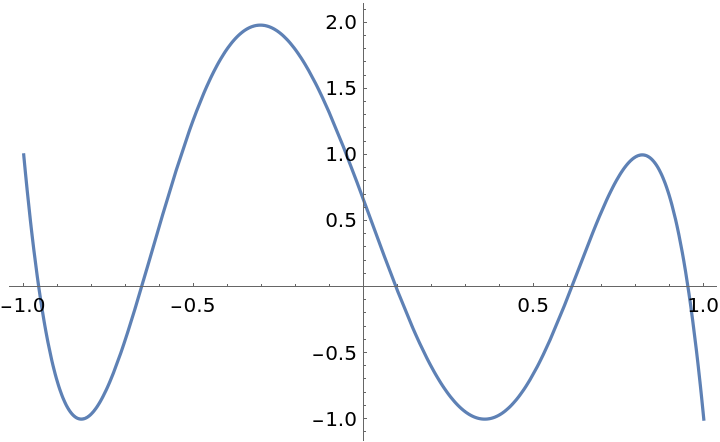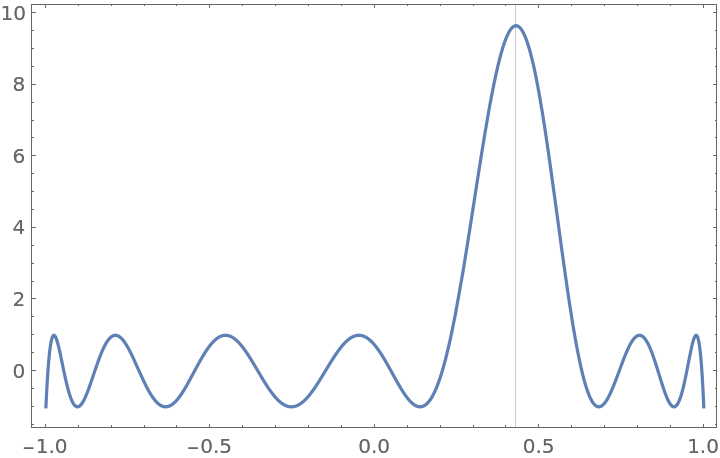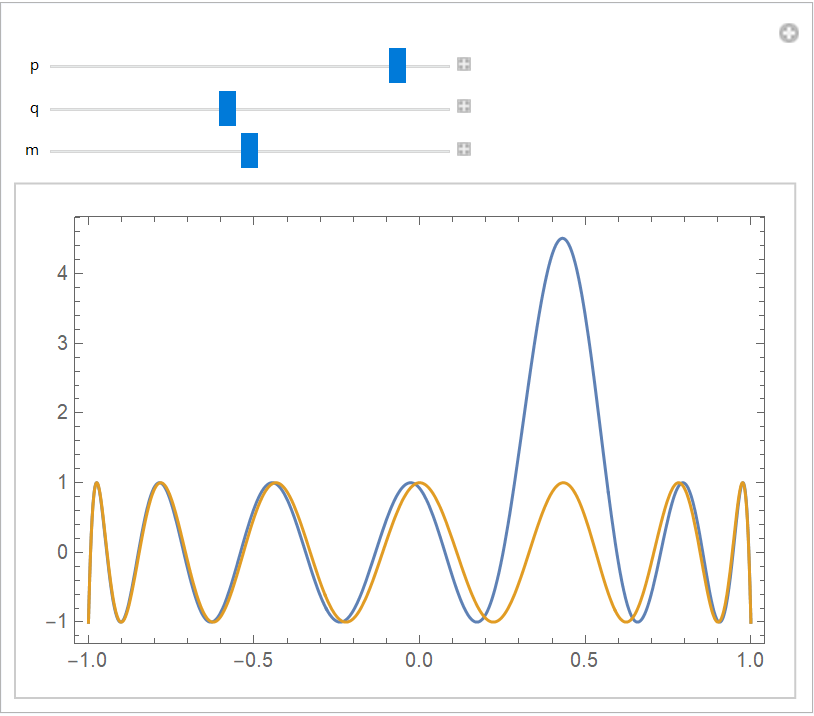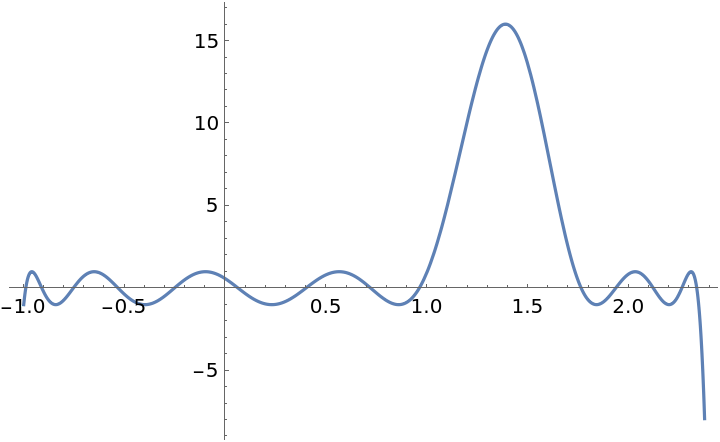Wolfram Function Repository
Instant-use add-on functions for the Wolfram Language
Function Repository Resource:
Evaluate the Zolotarev polynomial
ResourceFunction["ZolotarevZ"][p,q,x,m] gives the Zolotarev polynomial Zp,q(x|m). |
Evaluate numerically:
| In[1]:= |
| Out[1]= |
Plot over a subset of the reals:
| In[2]:= |
| Out[2]= |  |
Evaluate to high precision:
| In[3]:= |
| Out[3]= |
Evaluate with symbolic argument and numerical parameter:
| In[4]:= |
| Out[4]= |
ZolotarevZ threads elementwise over lists:
| In[5]:= |
| Out[5]= |
Plot a Zolotarev polynomial and show the location of its global maximum in [-1,1]:
| In[6]:= | ![With[{p = 9, q = 5, m = (78/100)^2},
Plot[ResourceFunction["ZolotarevZ"][p, q, x, m], {x, -1, 1}, Axes -> None, Frame -> True, GridLines -> {{2 JacobiCN[q/(p + q) EllipticK[m], m]^2 - 1 + 2 JacobiCN[q/(p + q) EllipticK[m], m] JacobiSD[
q/(p + q) EllipticK[m], m] JacobiZN[q/(p + q) EllipticK[m], m]}, None}, PlotRange -> All]]](https://www.wolframcloud.com/obj/resourcesystem/images/c0f/c0f0ac2f-3bca-4a92-9974-9058f5ea51d3/673863f73175ad0f.png) |
| Out[6]= |  |
Compare a Zolotarev polynomial with a Chebyshev polynomial of the same degree:
| In[7]:= | ![Manipulate[
Plot[{ResourceFunction["ZolotarevZ"][p, q, x, m], (-1)^q ChebyshevT[p + q, x]}, {x, -1, 1}, Axes -> None, Frame -> True, PlotRange -> All], {{p, 9}, 1, 10, 1}, {{q, 5}, 1, 10, 1}, {{m, 1/2}, 0, 1}]](https://www.wolframcloud.com/obj/resourcesystem/images/c0f/c0f0ac2f-3bca-4a92-9974-9058f5ea51d3/5d7966619d739095.png) |
| Out[7]= |  |
When m=0 or m=1, the Zolotarev polynomial is a scalar multiple of the Chebyshev polynomial ChebyshevT:
| In[8]:= |
| Out[8]= |
| In[9]:= |
| Out[9]= |
A parametric representation of the Zolotarev polynomial:
| In[10]:= | ![xzolo[p_, q_, u_, m_] := With[{rk = q/(p + q) EllipticK[m]}, JacobiCN[rk, m]^2 (JacobiSN[u, m]^2 + JacobiSN[rk, m]^2)/(
JacobiSN[u, m]^2 - JacobiSN[rk, m]^2) - JacobiSN[rk, m]^2]](https://www.wolframcloud.com/obj/resourcesystem/images/c0f/c0f0ac2f-3bca-4a92-9974-9058f5ea51d3/6ab17d4dffe26462.png) |
| In[11]:= | ![yzolo[p_, q_, u_, m_] := With[{rk = q/(p + q) EllipticK[m]}, (-1)^
q ChebyshevT[p + q, 1/2 (NevilleThetaS[u - rk, m]/NevilleThetaS[u + rk, m] + NevilleThetaS[u + rk, m]/NevilleThetaS[u - rk, m])]]](https://www.wolframcloud.com/obj/resourcesystem/images/c0f/c0f0ac2f-3bca-4a92-9974-9058f5ea51d3/33ed6c26f46b2ad3.png) |
Check equivalence with the explicit representation:
| In[12]:= | ![With[{p = 2, q = 3, u = N[4/3, 20], m = 2/3},
yzolo[p, q, u, m] - ResourceFunction["ZolotarevZ"][p, q, xzolo[p, q, u, m], m]]](https://www.wolframcloud.com/obj/resourcesystem/images/c0f/c0f0ac2f-3bca-4a92-9974-9058f5ea51d3/3bc7c552881db5ea.png) |
| Out[12]= |
The literature sometimes uses a different definition of the Zolotarev polynomial, where the polynomial is defined to have p zeroes in [-1,1]:
| In[13]:= | ![newZolo[p_, q_, x_, m_] := With[{rk = q/(p + q) EllipticK[m]}, ResourceFunction["ZolotarevZ"][p, q, JacobiCN[rk, m]^2 x - JacobiSN[rk, m]^2, m]]](https://www.wolframcloud.com/obj/resourcesystem/images/c0f/c0f0ac2f-3bca-4a92-9974-9058f5ea51d3/10c23a590472bab1.png) |
| In[14]:= |
| Out[14]= |  |
This work is licensed under a Creative Commons Attribution 4.0 International License